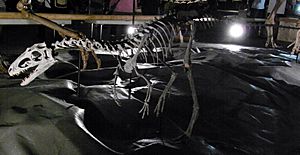Suskityrannus facts for kids
Quick facts for kids Suskityrannus |
|
|---|---|
 |
|
| Reconstructed skeleton at the Dinokingdom exhibition, Tokyo | |
| Scientific classification |
Suskityrannus is a type of tyrannosaur dinosaur. It was an early member of the group that includes the famous Tyrannosaurus rex. This dinosaur lived about 92 million years ago. Its fossils were found in what is now New Mexico.
Scientists first found Suskityrannus in the Zuni Basin area. This area is in western New Mexico. The dinosaur lived during a time called the Turonian age. This was part of the Cretaceous Period.
Contents
About Suskityrannus
Suskityrannus was a smaller tyrannosaur. It was not as big as its later relatives. Its name means "Zuni tyrant." This name honors the Zuni people of New Mexico. The dinosaur was formally named in 2019. Before that, it was sometimes called Zunityrannus.
What it Looked Like
Suskityrannus was a two-legged meat-eater. It likely had strong legs for running. Its arms were probably short, like other tyrannosaurs. The dinosaur was about 9 feet (2.7 meters) long. It weighed around 50 to 90 pounds (23 to 41 kilograms). This is about the size of a large dog.
Its Skull and Teeth
Scientists have found parts of its skull. These fossils show that Suskityrannus had sharp teeth. These teeth were good for eating meat. The skull also gives clues about its senses. It likely had good eyesight and smell. These senses helped it hunt prey.
Where it Lived
Suskityrannus lived in a warm, wet environment. This area is now the Moreno Hill Formation. It was likely a place with many plants and other animals. This provided food for the dinosaur. It would have hunted smaller animals.
When it Lived
This dinosaur lived during the Late Cretaceous period. Specifically, it was during the Turonian age. This time was important for dinosaurs. It was a period when many new types of dinosaurs appeared. Suskityrannus helps us understand how tyrannosaurs changed over time. It shows us how they grew from small hunters to giant predators.
Discovery and Study
The first fossils of Suskityrannus were found in the late 1990s. A team of scientists led by Doug Wolfe found them. The most complete fossil is called the "type specimen." This is the main example used to describe the species.
How Fossils Help Us Learn
Studying these fossils helps scientists. They learn about how Suskityrannus lived. They can figure out its size and what it ate. They also learn about its place in the dinosaur family tree. Suskityrannus is a key link. It connects the earliest tyrannosaurs to the giant ones.
Images for kids
See also
 In Spanish: Suskityrannus hazelae para niños
In Spanish: Suskityrannus hazelae para niños




